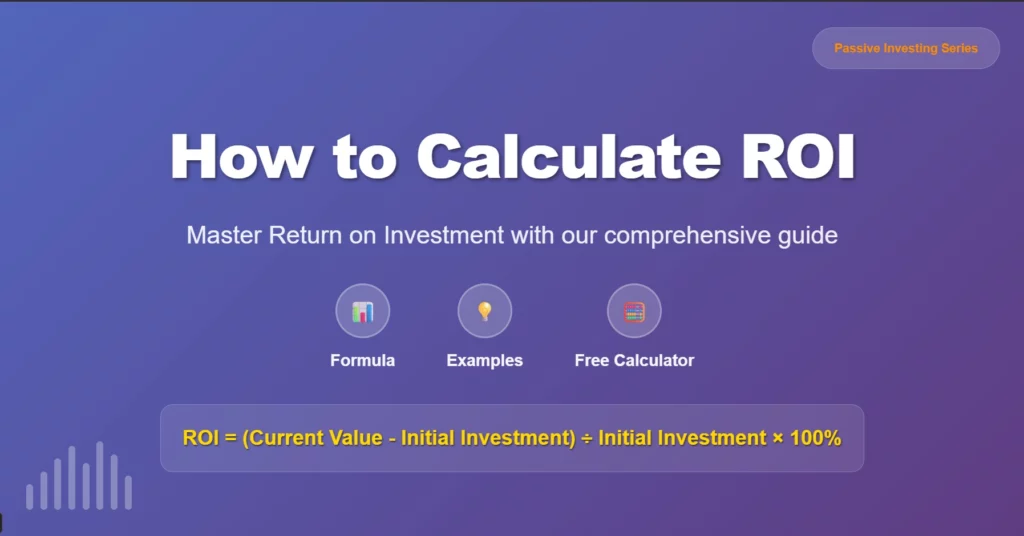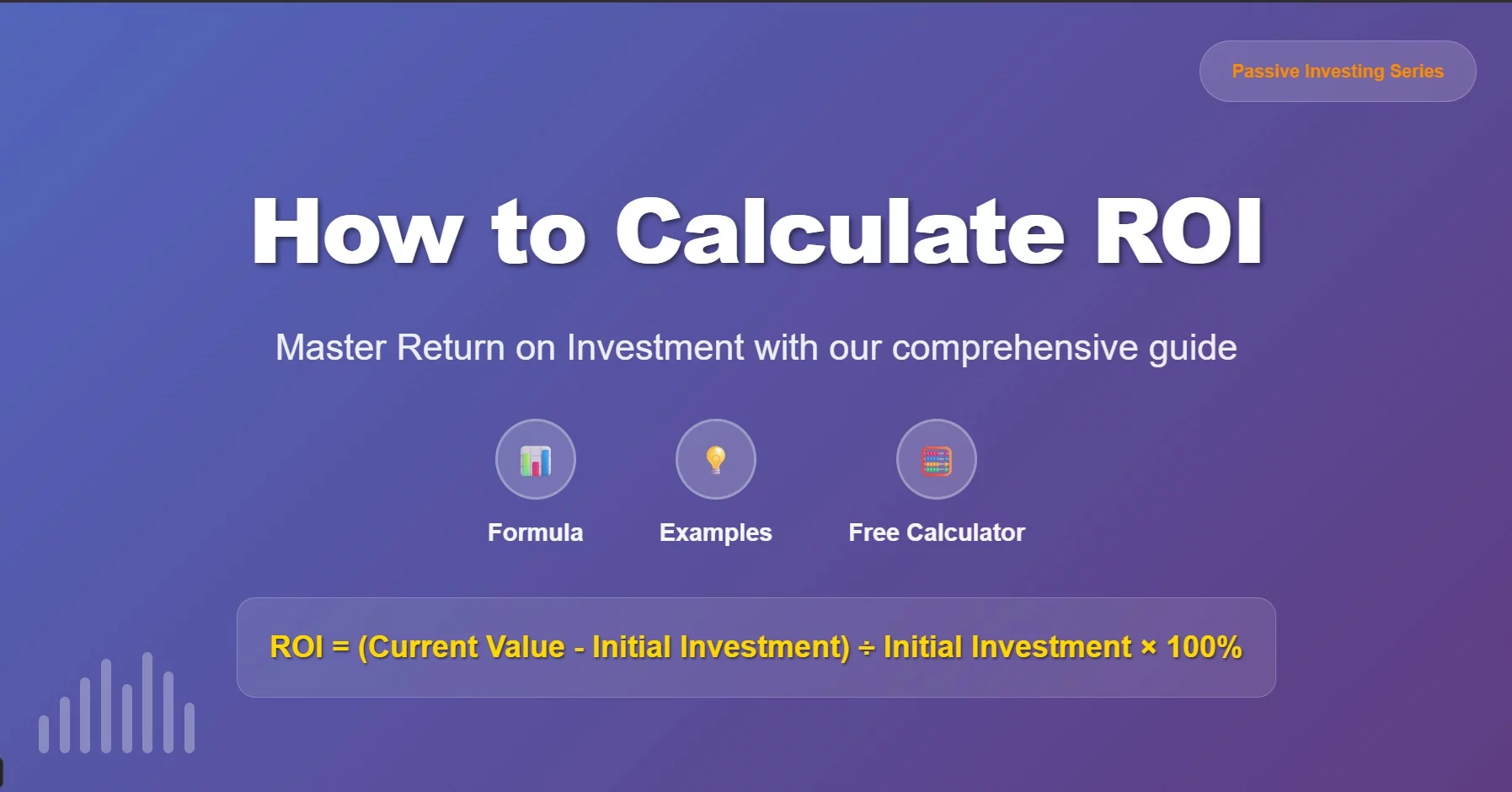You’ll hear traders brag about “up 20%!” — but unless you account for fees, income, taxes, and time, that number can be a mirage. Return on Investment (ROI) is the fast, comparable way to evaluate a position or project — and the place to start before you reach for CAGR, IRR, or any alphabet‑soup metrics.
This guide follows our Successful Tradings playbook: plain‑English formulas, a worked example, and a drop‑in calculator you can use on every trade. By the end, you’ll know when simple ROI is enough — and when to switch to annualized ROI/CAGR, IRR/XIRR, or TWRR so your comparisons stay fair.

In this guide you’ll learn to:
- compute ROI that includes fees and dividends/interest;
- annualize a short holding period and compare apples to apples;
- decide when to use CAGR vs. IRR/XIRR vs. TWRR;
- convert nominal returns to real (after‑inflation);
- and use our free calculator to do it all in seconds.
Time to read: ~5 minutes. Tool required: just the calculator below.
Quick answer: 🧮
ROI = (Value Received − Cost) / Cost.
Where Value Received = sale proceeds + dividends/interest; Cost = purchase price + fees/commissions.
Table of Contents
⭐ Key Takeaways
- 📈 ROI tells you how efficiently every invested dollar came back.
- 🧾 Always count fees and taxes; otherwise ROI is inflated.
- ⏱️ Use annualized ROI/CAGR to compare holdings with different time frames.
- 🔄 When there are deposits/withdrawals, use IRR/XIRR or TWRR instead of simple ROI.
- 🧮 The calculator below gives ROI, annualized ROI, and real (after‑inflation) ROI.
🧮 ROI Formula (with Definitions)
ROI = (Value Received − Cost) / Cost
Value Received = sale proceeds + dividends/interest.
Cost = purchase price + fees/commissions (and any other acquisition costs).
Tip: 💡 If you still own the position, plug in the current price (mark‑to‑market). That gives you an unrealized ROI.
🧮 ROI Calculator
Return on Investment (with Annualized & Real)
📝 Step‑by‑Step Example (with fees & dividends)
Scenario: Buy $1,000 of SPY; sell at $1,160; receive $20 dividends; pay $10 fees; held 12 months.
Profit = $1,160 + $20 − $1,000 − $10 = $170.
ROI = $170 / $1,000 = 17%.
Annualized ROI = (1+0.17)12/12−1(1+0.17)^{12/12} − 1(1+0.17)12/12−1 = 17%.
If inflation was 3% annual, real ROI ≈ 13.59%.
⏱️ Annualized ROI vs. CAGR (When to Use Which)
- Annualized ROI: use for single holding periods under ~24 months.
Annualized=(1+ROI)12/months−1\text{Annualized} = (1+\text{ROI})^{12/\text{months}} − 1Annualized=(1+ROI)12/months−1 - CAGR (Compound Annual Growth Rate): use for multi‑year, possibly multi‑period returns.
CAGR=(EndingBeginning)1/years−1\text{CAGR} = (\tfrac{\text{Ending}}{\text{Beginning}})^{1/\text{years}} − 1CAGR=(BeginningEnding)1/years−1
Rule of thumb: if you contributed or withdrew during the period, use IRR/XIRR instead (below).
💵 Cash‑Flowed Portfolios: IRR/XIRR vs. TWRR
- IRR/XIRR (money‑weighted): includes the timing and size of your deposits/withdrawals. Great for personal portfolios.
- TWRR (time‑weighted): neutralizes external cash flows; great for fund or strategy performance.
When to use
- You added money mid‑year → IRR/XIRR.
- You want to compare funds/managers → TWRR.
🌡️ Real (After‑Inflation) ROI
Inflation eats part of your return. Convert a nominal return to real by:
Real=1+Nominal1+Inflation−1\text{Real} = \frac{1+\text{Nominal}}{1+\text{Inflation}} – 1Real=1+Inflation1+Nominal−1
🧾 Fees & Taxes: The Quiet ROI Killers
- Include commissions/expense ratios in cost.
- For taxable accounts, compare returns after tax when relevant.
- Prefer low‑cost index funds/ETFs for passive allocations.
⚠️ Common Mistakes to Avoid
- Comparing a 3‑month ROI to a 3‑year ROI.
- Ignoring fees, slippage, or taxes.
- Using ROI for cash‑flowed strategies (use IRR/XIRR).
- Cherry‑picking start/end dates.
❓ FAQs
Is ROI the same as profit margin?
No. Margin divides by revenue; ROI divides by investment cost.
Is ROI always annualized?
No. ROI is period‑based. Annualize only when you need to compare across time frames.
Which is better: ROI or CAGR?
For multi‑year holds without extra cash flows, CAGR summarizes the annual pace cleanly. For a single trade/holding, ROI is fine.
What if I only have partial sale or open positions?
Use the current market value (mark‑to‑market) for Value Received.
🎯 Final Thoughts
ROI is the front door to understanding performance.
Therefore, you must use it for quick clarity, annualize to compare time frames, and switch to IRR/TWRR when cash flows enter the chat.
Combine the calculator with disciplined reviews and you’ll keep your analysis clean, fast, and comparable across passive or active investments.
Read NExt: Webull Calculator

Hold a Master Degree in Electrical engineering from Texas A&M University.
African born – French Raised and US matured who speak 5 languages.
Active Stock Options Trader and Coach since 2014.
Most Swing Trade weekly Options and Specialize in 10-Baggers !
YouTube Channel: https://www.youtube.com/c/SuccessfulTradings
Other Website: https://237answersblog.com/
